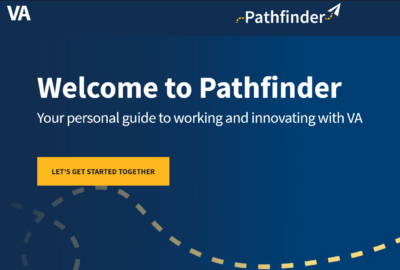New VA portals provide simplicity, transparency to vendor interactions
In addition to providing a one-stop shop for contractors, VA is trying to build a culture of transparency on the IT side, in order to make it easier for vendors...
The Department of Veterans Affairs is trying to streamline how contractors interact with the department. Last month it announced the Pathfinder site, a new digital one-stop shop for contractors looking to work with the VA. On June 7, that website officially went live.
“This is a focused point of entry to selling and innovating with VA for our industry partners,” said Michael Parrish, VA’s chief acquisition officer, in a press release. “It fills a gap we’ve found in the acquisition lifecycle by creating the fusion of acquisition and innovation with this intelligent system.”
Parrish said last month that the new Pathfinder site will help vendors that haven’t worked with VA before getting certified through SAM.gov. But the site will also pre-filter to show only VA-specific solicitations.
“One of the great things about [the Pathfinder tool] is that it does provide a connection to that more innovative area,” said Charles Worthington, chief technology officer for VA’s Office of Information Technology. “So in cases where it’s a solution that the community thinks might help solve a problem that VA has, there is a path that it’ll lead you down, that can kind of flag you into that.”
Luwanda Jones, deputy chief information officer at VA, said during a VA Advanced Planning Brief to Industry on June 8 that the site will also facilitate vendor engagement scheduling. Eventually, she said, it will replace the VA’s IT Vendor Management Office scheduling email.
But Pathfinder isn’t the only way VA is trying to make it easier for vendors to work with them. Worthington said VA is trying to build a culture of transparency on the IT side, especially with vendors, in order to make it easier for them to integrate solutions. That’s evidenced in the new Lighthouse program, Worthington said.
Previously, he said, the team behind Lighthouse was primarily focused on vendors building third-party applications on top of VA services. For example, that might include a veteran linking their VA medical records to an approved health care app on their phone.
But now that team is turning its focus to internal interfaces as well.
“You’re going to be seeing more about this in the coming weeks and months. But what we’re really hoping to do is for all the different systems that run within our VA internal environment, we want to document the interfaces that those systems provide, and make it easy for teams to use those interfaces,” Worthington said. “We want to focus on making it easy for teams to leverage existing capabilities that are existing in other systems. And Lighthouse is a key way that’s going to help us do that. So more to come on this but keep your eyes open. And really, teams should be thinking about the core transactional capabilities of whatever system you’re working on. Exposing those to other systems in a standard way with an API is really the approach that has been most successful for integrating systems at VA, and we’re going to be leaning into that even more with our Lighthouse Developer Experience platform.”
Worthington also mentioned a VA design portal that’s intended to provide style and format guidance to contractors working with VA, in order to match the look and feel of the VA website. The idea is to ensure consistency across all communications involving the VA. Worthington said that can range from as simple as whether or not to capitalize the V in veterans, to technical minutiae like fonts, margins and color palettes.
Finally, Worthington discussed a shared service for notifications that VA is beginning to implement on its internal network. It will allow vendors to send personalized notifications to veterans via email or text. So, for example, they can let veterans know their application was received, or their prescription was updated. Worthington said the service is already integrated with VA’s veteran profile databases, as well as with its veterans preference engines. It also has a high level of trust with email providers, meaning it’s more likely to bypass spam filters.
Copyright © 2024 Federal News Network. All rights reserved. This website is not intended for users located within the European Economic Area.
Daisy Thornton is Federal News Network’s digital managing editor. In addition to her editing responsibilities, she covers federal management, workforce and technology issues. She is also the commentary editor; email her your letters to the editor and pitches for contributed bylines.
Follow @dthorntonWFED






